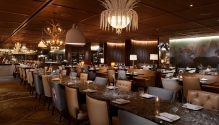Designing Hotels for Remote Locations
Building hotels in extreme locations isn’t just about architecture—it’s about vision, resilience, and redefining what’s possible. Architects, hoteliers, and hospitality brands share how they balance sustainability, accessibility, and luxury in some of India’s most breathtaking yet challenging landscapes.
By Rupali Sebastian
At first glance, setting up a hotel in a remote location seems like an uphill battle. Infrastructure is scarce, logistics are complex, and operational costs can skyrocket. Steep topography (in mountainous terrains), unpredictable weather, and seasonal constraints make construction and maintenance challenging. Designing for remote locations is never a one-size-fits-all exercise; each site demands a tailored approach that accounts for its unique environmental and regulatory conditions.
Yet, as tourism evolves, travellers are moving beyond conventional destinations, seeking immersive, authentic experiences—places that are destinations in themselves. “In remote locations, guest experience management often extends beyond the hotel premises,” says Suma Venkatesh, Executive Vice President - Real Estate & Development, IHCL. When done right, hotels in these settings don’t just offer a stay; they redefine a region’s economy, culture, and identity.
This vision of transformative hospitality drove Rigzin Kalon to establish Lchang Nang Retreat (a RARE hotel) in Nubra. With Ladakh’s tourism boom threatening its fragile ecosystem, he saw an urgent need for sustainable hospitality. “No hotels were being built or operated with sustainability in mind. So, I decided to create a venture grounded in environmental, cultural, and social sustainability,” he says. Choosing the location—a remote, non-touristy village in Nubra Valley—was deliberate. “We’ve been able to extend the fruits of tourism to our side of the valley.”
In Sikkim, Harshavardhan Neotia, Chairman, Ambuja Neotia Group, was drawn to the eastern Himalayas’ dense foliage and panoramic views. A casual conversation led him to a property in Pangthang, just a short drive from Gangtok but perched 1,500ft. above it. A visit on a bright, crisp morning sealed the decision. Standing amid pine forests with Mt. Kangchenjunga in full view, he envisioned a space that would blend seamlessly with the landscape. The result was Taj Guras Kutir Resort & Spa, a retreat designed to amplify the natural beauty rather than compete with it.
A similar sentiment guided Maulik Bhagat, CEO, 1000 Island Hotels and Resorts, whose luxury retreat, Woods at Sasan, was born from a childhood memory. “I visited Sasan Gir as a child and spotting a lion left a lasting impression,” he recalls. Years later, he realised that while travellers flocked overseas for wildlife experiences, India—home to the last Asiatic lions—was often overlooked. Determined to reposition Gir as a luxury destination, he created a property (which now enjoys the Relais & Chateau label) that connects design, dignity, and experience, challenging perceptions of what a wildlife getaway could be.
Remote locations come with undeniable challenges, but for those willing to embrace the complexity, they also offer unmatched opportunities—to create something meaningful, to shape a destination, and to offer travellers experiences that are truly one of a kind.

Hotels in these settings don’t just offer a stay; they redefine a region’s economy, culture, and identity.

Vivanta Arunachal Pradesh, Tawang's 80 well-appointed rooms afford fantastic views of the eastern Himalayas.

Suma Venkatesh, Executive Vice President-Real Estate & Development, IHCL
In remote locations, guest experience management often extends beyond the hotel premises.
Suma Venkatesh
Executive Vice President - Real Estate & Development, IHCL

Bringing the unreachable within reach
For architects and developers, accessibility is often the single biggest challenge when designing hotels in remote locations, testing both resilience and patience.
"When I first visited the site," says Anil Sharma, Principal Architect, A Sharma Associates and the mind behind The Khyber Himalayan Resort & Spa in Gulmarg, "there was six feet of snow. I was walking behind my team when I suddenly found myself waist-deep, unable to move. The others were far ahead, not looking back. I had to shout for help."
Yet, even amid the harsh conditions, inspiration struck. "The next day, when I visited the site again, I had a wooden stick in my hand and began sketching directly in the snow. The vision for Khyber was born right there—where the rooms would be, the lobby, the pool. Later, I redrew it on a hotel notepad."
But translating that vision into reality required more than creative instinct. Material transportation, seasonal constraints, and extreme weather made the project one of the most challenging builds in India. "Roads had to be built for small trucks, climbing 600mtrs. in elevation. We had only six months of workable weather per year. Every decision had to factor in these conditions," Sharma explains.
Mandar Zaware, VP-Design & Project Management, Global Design APEC, Marriott International, echoes the necessity of infrastructure planning and land development in remote locations. Taking JW Marriott Shimla, currently being built about 25kms. away from Himachal Pradesh’s capital city as an example, he says: “We had to create an additional road network—not for the resort’s guests, but purely for construction logistics. This wasn’t part of the overall resort planning but was critical to ensuring that materials and equipment could be transported efficiently. It was an added expenditure, but essential to execution.”
Even when materials are accessible, the challenge lies in optimising the terrain to support both construction and long-term operations. But what happens when procuring materials itself becomes a challenge? The answer is simple: look around.
“Construction is a challenge in Nubra Valley. It’s difficult to get building materials to Nubra and it became prohibitively expensive to source items,” says Kahlon. “The cost of labour is also high. However, we overcame all this by resorting to traditional materials for building. Even though our resort is located in a remote location, we had abundant construction materials like stone, mud, wood, etc. We went for vernacular architecture by employing local masons.”
Construction of Woods at Sasan, too, prioritised local materials such as stone—specifically the bela stone covered with lime plaster for a cooling effect—timber and reclaimed wood. “This not only minimised transportation emissions, but also ensured that the property blended harmoniously with its surroundings,” points out Bhagat.
JW Marriott Shimla, while enjoying access to materials from both Chandigarh and Shimla, seamlessly integrates local resources into its design. The “beautiful beige-coloured stone” unearthed during excavation was repurposed for pathways and retaining walls, crafted under the expert hands of local masons skilled in traditional techniques. “This creates a connection to the land,” notes Zaware.

Planning is the backbone of any remote hospitality project.

The meticulous planning of The Khyber Himalayan Resort & Spa took into consideration the brief six-month workable weather per year.

Harshavardhan Neotia, Chairman, Ambuja Neotia Group
Our intent was to ensure that the built-form of Taj Guras Kutir remained subtle, a quiet companion to the true spectacle—the grandeur of the mountains and the richness of the forest.
Harshavardhan Neotia
Chairman, Ambuja Neotia Group


Mandar Zaware, VP-Design & Project Management, Global Design APEC, Marriott International
You have to think beyond just housing the staff—you need to provide medical facilities, stores for daily essentials, and spaces for recreation. It’s like designing a small town within the resort itself.
Mandar Zaware
VP-Design & Project Management, Global Design APEC, Marriott International

The land takes centre stage
In meaningful architecture, the land should always be the hero. But in remote hospitality, it goes beyond that—natural features don’t just shape the design; they define the entire experience. The land becomes the architect, the storyteller, and the experience itself, and the hotel becomes an extension of the landscape, seamlessly blending into its surroundings to create a place-led journey.
At the upcoming JW Marriott Shimla, the land was the first consideration. “The site is stunning—it sits within a valley, surrounded by mountains and layered with natural contours,” says Zaware. “We wanted to retain this topography, which led us to adopt a tiered approach. The architecture is spread across multiple levels, each connected yet distinct.” A natural stream that runs through the site became another integral element of the design. Rather than rerouting it, the team built around it. During the monsoons, the water collects at the lowest level—where the spa is positioned. This reservoir not only enhances the guest experience with its seasonal transformations but also serves a practical function. “Shimla faces water scarcity in the summers, and this reservoir will be used for irrigation, keeping the landscape fresh. In winter, it will freeze over, creating an entirely different visual and sensory experience,” he explains.
At Woods At Sasan, too, the land is the blueprint. “The contours of the site dictated our design approach,” says Bhagat. “Only 12-17% of the land is covered by structures, with 30% of the built-area designed as semi-open spaces.” The dense tree cover and mango orchards also played a crucial role in defining the layout, ensuring that the architecture remains unobtrusive and in harmony with its natural setting. “We designed around what already existed rather than imposing on it, allowing the property to feel like an organic part of the landscape.”
At Taj Guras Kutir, the architecture is deliberately restrained, allowing the landscape to take precedence. Though the structure spans seven levels, guests arriving at the property see only two, creating an intimate, almost hidden feel. From there, the journey is carefully choreographed—spaces unfold gradually, culminating in a breathtaking reveal of the valley, framed by the towering Kangchenjunga and the vast Himalayan range. “Our intent was to ensure that the built-form remained subtle, a quiet companion to the true spectacle—the grandeur of the mountains and the richness of the forest,” says Neotia.

Rigzin Kalon, Owner, Lchang Nang Retreat
By using locally sourced materials with inherent insulating properties, we’ve significantly reduced the energy needed to regulate indoor temperatures.
Rigzin Kalon
Owner, Lchang Nang Retreat

Being earth-conscious is the only way
“The only good architecture is climate-responsive architecture,” emphasises Sharma. At The Khyber, this philosophy is woven into every detail—from insulated walls clad in locally sourced walnut wood to a comprehensive water management system. Even the heating process is optimised through a smart heat recovery system, reducing energy consumption while ensuring guest comfort in the harsh Himalayan climate.
Kalon highlights the resort’s commitment to sustainability—its raison d’etre—through solar-passive construction, which naturally minimises the need for artificial heating and cooling. "The entire resort is powered by a 20kw solar system, with solar water heaters catering to all hot water requirements. By using locally sourced materials with inherent insulating properties, we’ve significantly reduced the energy needed to regulate indoor temperatures," he explains.

Merging into the landscape, the contemporary 38-key Woods at Sasan, Gir, is located in an eight-acre mango orchard.

Anil Sharma, Principal Architect, A Sharma Associates
For The Khyber Himalayan Resort & Spa, we had only six months of workable weather per year. Every decision had to factor in these conditions.
Anil Sharma
Principal Architect, A Sharma Associates

At Taj Guras Kutir, preserving the natural topography was a priority. Neotia highlights how the team meticulously reduced interference with the land’s natural contours while safeguarding the surrounding greenery by re-routing rainwater collected from the site into an existing natural water channel. “I think this is one of the most significant steps we took for environmental sustainability at Guras Kutir,” he states. “This effort ensures that rainwater is directed safely and remains uncontaminated, benefitting the communities downstream who rely on this water source. By carefully managing the water flow, we not only protect the surrounding landscape but also help maintain a sustainable water resource for local residents.”
For Venkatesh, sustainable hospitality is a layered concept, spanning the initial design stages to construction and long-term operations. "It begins with architects and designers focusing on ecological sustainability, understanding the cultural and built environment of the region, and complementing traditional design with contemporary touches," she explains. Some of the best examples of this design ethos can be seen in Taj Wayanad, where the building plan minimises land-cutting, incorporates large non-air-conditioned spaces, enhances natural lighting through specially designed skylights, and uses indigenous materials for both interiors and exteriors. A similar principle was applied at Taj Exotica Resort & Spa, Andamans, where the resort was constructed without felling a single tree. Instead, it was built using plantation timber, with rooms featuring thatched roofs inspired by the indigenous Jarawa architecture.

The design of Taj Wayanad Resort & Spa Kerala minimsed felling of trees and focused on natural materials and lighting.

The multi-level architecture of Taj Guras Kutir ensures an intimacy of scale as guests arriving at the property see only a part of the whole at any given time.
The invisible city
Building a hotel in a remote location doesn’t just require careful planning for guests—it demands equal, if not greater, attention to the workforce that constructs and eventually operates it. Unlike urban projects where labourers and staff can return home after work, those involved in remote hospitality developments are stationed on-site for months at a time. This presents a unique set of challenges, from accommodation and sustenance to mental well-being and recreation.
Zaware, citing the example of the recently opened JW Marriott Maldives Kaafu Atoll Island Resort, highlights this reality: "In places like the Maldives, a resort may have only 60 to 80 keys, but they require a staff strength of around 300 to run it seamlessly. These employees are stationed on the island, far from urban conveniences. You have to think beyond just housing them—you need to provide medical facilities, stores for daily essentials, and spaces for recreation. It’s like designing a small town within the resort itself."
During the construction phase, the situation is no different. Labourers working in remote locations remain on-site for extended periods, often cut off from their families and social lives. Ensuring their well-being means creating not just temporary housing, but also spaces for relaxation and engagement. "You can’t expect workers to function at their best if they have no respite. There’s no city mall to visit on weekends, no easy way to unwind," Zaware points out.
Venkatesh says: “Such developments are marked by stark seasonality, inconsistent access, poor social and medical infrastructure and erratic supply chain. To run smooth operations in such regions, IHCL focuses on developing a holistic work environment to attract and retain the best of talent. This includes facilities such as accommodation for families, recreation options, compensation and benefits policies to suit the location’s hardship and redeployment to main cities during off-season. Ultimately, hospitality in remote locations isn’t just about crafting a luxury escape for guests—it’s about fostering an environment where those behind the scenes can thrive too."
As travellers increasingly seek immersive, experiential, and offbeat destinations, the demand for hotels in remote locations is only expected to rise. After all, luxury is no longer about opulence—it’s about authenticity, connection, and a sense of place.

At Taj Exotica Resort & Spa, Andamans, the thatched roofs of the cottages are a nod to the local Jarawa architecture.

Travellers are moving beyond conventional destinations, seeking immersive, authentic experiences—places that are destinations in themselves.

Maulik Bhagat, CEO, 1000 Island Hotels And Resorts
We designed around what already existed rather than imposing on it, allowing the property to feel like an organic part of the landscape.
Maulik Bhagat
CEO, 1000 Island Hotels And Resorts



























